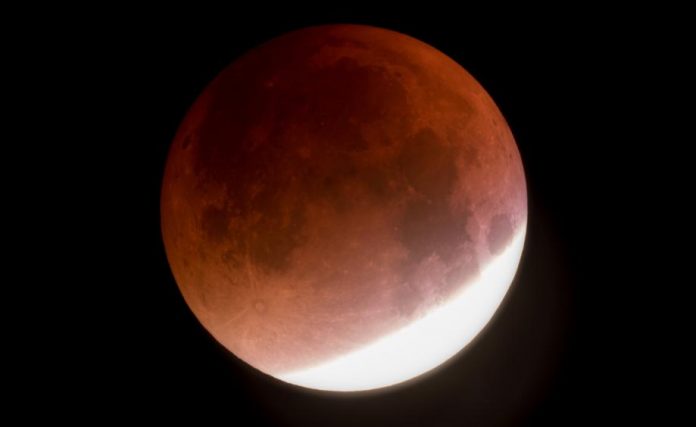Lunar eclipse on Friday: No part of the moon enters Earth.
Ready for the very first lunar eclipse of the year? The first eclipse season of 2020 comes to an end Friday, with a penumbral lunar eclipse. This season overlaps with 2019, when it kicked off with the Boxing Day annular solar eclipse of December 26th, 2019.
What is a penumbral eclipse? Unfortunately as eclipses go, penumbrals are the most subtle of all events, as the Moon just grazes the outer bright shadow of the Earth. When the Moon fully enters the Earth’s inner dark shadow known as the umbra, a total lunar eclipse occurs.
Why the two shadows? Shouldn’t a large body such as the Earth cast one huge shadow with a distinct edge? That would indeed be the case… if the Sun was a pinpoint source, with no angular size. One handy way to think of this is to journey to the Moon and imagine the view of the scene on Friday from the lunar surface. From the Moon, you would see a partial solar eclipse during Friday’s Earthbound penumbral lunar eclipse:
Eclipses occur in seasons because the Moon’s orbit is inclined just over 5 degrees versus the ecliptic plane, which traces out the Earth’s path around the Sun. For an eclipse to occur, the intersection of the Moon’s orbit along the ecliptic (known as its ascending or descending node) must be near New (solar eclipse) or Full (lunar eclipse) Moon for an eclipse to occur. This week, the Moon crosses ascending node on January 9th at ~23:00 UT, about 20 hours prior to Friday’s eclipse.
Visibility prospects: Asia, Europe and northeastern Africa will see Friday’s lunar eclipse in its entirety. Western Africa and the Canadian Maritimes will see the eclipse underway at moonrise, and Australia will see the eclipse during moonset. South America and most of North America will sit this one out.
Here are the key times for Friday’s eclipse in Universal Time (UT):
P1- First contact of the limb of the Moon with the Earth’s penumbra: 17:08 UT
Mid-Eclipse: 19:11 UT
P2-The Moon exits the Earth’s penumbra: 21:12 UT
2020 hosts six eclipses in all: two solar (an annular eclipse on June 21st, and a total solar eclipse on December 14th) and four lunar eclipses all penumbral. These occur on January 10th, June 5th, July 5th, November 30th. When was the last year with penumbrals only? Well, 2002 hosted three penumbral lunar eclipses, and 2027 will also see three penumbral lunar eclipses… but the next year with four isn’t until one saros cycle from now in 2038.
It’s worth noting that the middle eclipse season for 2020 is book-ended by two lunar eclipses and hosts three eclipses, another rarity.
Would you notice Friday’s penumbral lunar eclipse at all at a casual glance? Well, the Moon juuuust misses the edge of the inner umbra by 3’… perhaps, you might see a ragged bit of shading on the Moon’s southern limb at maximum eclipse, due to atmospheric scattering. The Moon is 90% immersed in the penumbra at maximum. Look for a bit of tea-colored shading on the Moon around mid-eclipse.
Here’s a neat trick to tease out the penumbral lunar eclipse. Take a photograph of the Moon just before the eclipse starts, then one at mid-eclipse, then one immediately afterwards. Do you see the subtle color difference?
Clouded out, or live in the wrong hemisphere? The good folks at the Virtual Telescope Project have got you covered, with a live webcast of Friday’s eclipse from Rome, Italy. The webcast starts at 17:00 Universal Time (UT)/Noon U.S. Eastern Standard Time (EST).













